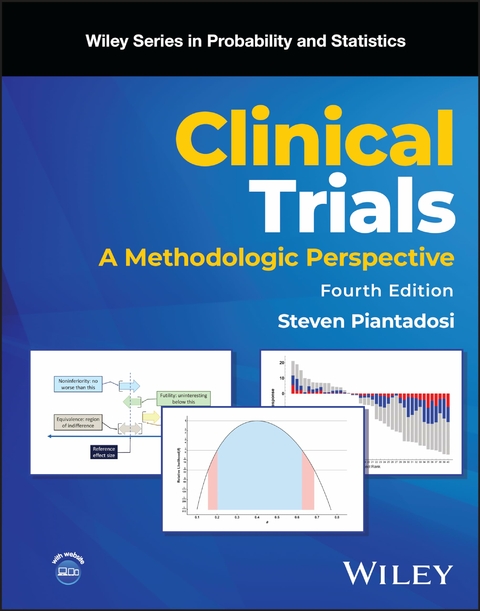
Clinical Trials
John Wiley & Sons Inc (Verlag)
978-1-394-19566-4 (ISBN)
The Fourth Edition of »Clinical Trials« builds on the text’s reputation as a straightforward, detailed, and authoritative presentation of quantitative methods for clinical trials, discussing principles of design for various types of clinical trials and elements of planning the experiment, assembling a study cohort, assessing data, and reporting results.
Each chapter contains an introduction and summary to reinforce key points. Discussion questions stimulate critical thinking and help readers understand how they can apply their newfound knowledge.
Written by a highly qualified author with significant experience in the field, the Fourth Edition of »Clinical Trials« approaches the topic with:
- Problems that may arise during a trial, and accompanying common sense solutions
- Design alternatives for addressing many questions in therapeutic development
- Statistical principles with new and provocative topics, such as generalizing results, operating characteristics, trial issues during the COVID-19 pandemic, and more
- Alternative medicine, ethics, middle development, comparative studies, adaptive designs, and clinical trials using point of care data
- Revamped exercise sets, updated and extensive references, new material on endpoints and the developmental pipeline, and revisions of numerous sections, tables, and figures
Standing out due to its accessible and broad coverage of statistical design methods which are the building blocks of clinical trials and medical research, »Clinical Trials« is an essential learning aid on the subject for undergraduate and graduate clinical trials courses.
Steven Piantadosi, MD, PhD, is Professor in Residence at Brigham and Women’s Hospital and Harvard Medical School. He is one of the world’s leading experts on the design and analysis of clinical trials. Dr. Piantadosi has been engaged with clinical trials for over 4 decades and taught the subject for more than 30 years. His research has focused on cancer but has involved many other therapeutic areas as well. He has published over 275 papers on research results, clinical applications, and trial methodology. Dr. Piantadosi has held leadership roles with national cooperative oncology groups, including the Alliance, a National Clinical Trials Network collaboration. He has also served as a member of numerous advisory and clinical trial monitoring committees.
Preface xxi
About the Companion website xxv
1 Preliminaries 1
1.1 Introduction 1
1.2 Deconstruction 2
1.3 A Clinical Trial is a Test of Treatment Under Controlled Conditions 3
1.4 Audience 3
1.5 Scope 4
1.6 Other Sources of Knowledge 5
1.8 Programs Examples and Data 8
1.9 Summary 9
2 Clinical Trials as Research 10
2.1 Introduction 10
2.2 Research 12
2.3 Defining Clinical Trials 17
2.4 Practicalities of Usage 24
2.5 Non-Experimental Designs 30
2.6 Summary 34
2.7 Questions for Discussion 34
3 Why Clinical Trials Are Ethical 35
3.1 Introduction 35
3.2 Duality is Ever Present 38
3.3 Historically Derived Principles of Ethics 46
3.4 Contemporary Foundational Principles 52
3.5 Methodologic Reflections 57
3.6 Professional Conduct 62
3.7 Summary 67
3.8 Questions for Discussion 67
4 Contexts for Clinical Trials 69
4.1 Introduction 69
4.2 Drugs 72
4.3 Devices 75
4.4 Prevention 77
4.5 Complementary and Alternative Medicine 83
4.6 Surgery and Skill-Dependent Therapies 90
4.7 A Brief View of Some Other Contexts 100
4.8 Summary 103
4.9 Questions for Discussion 104
5 Measurement 105
5.1 Introduction 105
5.2 Objectives 107
5.3 Measurement Design 109
5.4 Surrogate Outcomes 126
5.5 Summary 132
5.6 Questions for Discussion 132
6 Random Error and Bias 133
6.1 Introduction 133
6.2 Bias in Clinical Trials 140
6.3 Statistical Bias 145
6.4 Summary 149
6.5 Questions for Discussion 150
7 Statistical Perspectives 151
7.1 Introduction 151
7.2 Differences in Statistical Perspectives 152
7.3 Frequentist 155
7.4 Bayesian 157
7.5 Likelihood 161
7.6 Statistics Issues 164
7.7 Summary 165
7.8 Questions for Discussion 166
8 Experiment Design in Clinical Trials 167
8.1 Introduction 167
8.2 Trials as Simple Experiment Designs 168
8.3 Goals of Experiment Design 171
8.4 Design Concepts 173
8.5 Design Features 176
8.6 Special Design Issues 181
8.7 Importance of Protocol Documents 186
8.8 Summary 193
8.9 Questions for Discussion 193
9 Trial Cohorts 195
9.1 Introduction 195
9.2 Cohort Definition and Selection 196
9.3 Modeling Accrual 202
9.4 Inclusiveness Representation and Interactions 205
9.5 Summary 211
9.6 Questions for Discussion 211
10 Development Paradigms 213
10.1 Introduction 213
10.2 Pipeline Principles and Problems 216
10.3 A Simple Quantitative Pipeline 219
10.4 Late Failures 224
10.5 Summary 230
10.6 Questions for Discussion 231
11 Translational Clinical Trials 232
11.1 Introduction 232
11.2 Inferential Paradigms 236
11.3 Evidence and Theory 239
11.4 Translational Trials Defined 241
11.5 Information from Translational Trials 244
11.6 Summary 252
11.7 Questions for Discussion 252
12 Early Development and Dose Finding 253
12.1 Introduction 253
12.2 Essential Concepts 254
12.3 Dose Ranging 260
12.4 Bayesian Optimal Interval (BOIN) Design 266
12.5 Model-Guided Dose Finding 267
12.6 General Dose-Finding Issues 276
12.7 Summary 284
12.8 Questions for Discussion 286
13 Middle Development 287
13.1 Introduction 287
13.2 Characteristics of Middle Development 289
13.3 Design Issues 291
13.4 Middle Development Distills True Positives 293
13.5 Futility and Non-superiority Designs 295
13.6 Dose Efficacy Questions 298
13.7 Randomized Comparisons 299
13.8 Cohort Mixtures 304
13.9 Summary 306
13.10 Questions for Discussion 307
14 Comparative Trials 308
14.1 Introduction 308
14.2 Elements of Reliability 309
14.3 Biomarker-Based Comparative Designs 313
14.4 Other Comparative Designs 317
14.5 Summary 320
14.6 Questions for Discussion 321
15 Adaptive Design Features 322
15.1 Introduction 322
15.2 Some Familiar Adaptations 325
15.3 Biomarker Adaptive Trials 330
15.4 Re-Designs 331
15.5 Seamless Designs 332
15.6 Barriers to AD 333
15.7 Adaptive Design Case Study 333
15.8 Summary 334
15.9 Questions for Discussion 334
16 Precision Sample Size and Power 335
16.1 Introduction 335
16.2 Principles 336
16.3 Early Developmental Trials 339
16.4 Simple Estimation Designs 341
16.5 Event Rates 352
16.6 Stages 355
16.7 Comparative Trials 358
16.8 Expanded Safety Trials 377
16.9 Other Considerations 380
16.10 Summary 386
16.11 Questions for Discussion 387
17 Treatment Allocation 389
17.1 Introduction 389
17.2 Randomization 390
17.3 Constrained Randomization 395
17.4 Adaptive Allocation 398
17.5 Other Issues Regarding Randomization 401
17.6 Unequal Treatment Allocation 406
17.7 Randomization Before Consent 410
17.8 Summary 410
17.9 Questions for Discussion 411
18 Monitoring Treatment Effects 412
18.1 Introduction 412
18.2 Administrative Issues in Trial Monitoring 415
18.3 Organizational Issues Related to Monitoring 422
18.4 Statistical Methods for Monitoring 428
18.5 Summary 447
18.6 Questions for Discussion 448
19 Counting Subjects and Events 450
19.1 Introduction 450
19.2 Imperfection and Validity 451
19.3 Treatment Nonadherence 452
19.4 Protocol Nonadherence 455
19.5 Data Imperfections 457
19.6 Summary 461
19.7 Questions for Discussion 461
20 Estimating Clinical Effects 462
20.1 Introduction 462
20.2 Dose-Finding and Pharmacokinetic Trials 465
20.3 Middle Development Studies 470
20.4 Randomized Comparative Trials 475
20.5 Problems With P-Values 483
20.6 Strength of Evidence Through Support Intervals 487
20.7 Special Methods of Analysis 488
20.8 Vaccine Trials 494
20.9 Exploratory Analyses 496
20.10 Summary 504
20.11 Questions for Discussion 504
21 Generalizing Results From Clinical Trials 508
21.1 Introduction 508
21.2 Laboratory Lessons 510
21.3 Sample-Based Generalization 510
21.4 Reconciling New Findings with Old Data 512
21.5 Fit for Purpose Data 513
21.6 Shared Biology 514
21.7 Learning from Harmful Effects 515
21.8 Pandemic 516
21.9 Summary 517
21.10 Questions for Discussion 517
22 Prognostic Factor Analyses 518
22.1 Introduction 518
22.2 Model-Based Methods 520
22.3 Adjusted Analyses of Comparative Trials 531
22.4 Pfas Without Models 534
22.5 Summary 538
22.6 Questions for Discussion 538
23 Factorial Designs 539
23.1 Introduction 539
23.2 Characteristics of Factorial Designs 540
23.3 Treatment Interactions 542
23.4 Examples of Factorial Designs 546
23.5 Partial Fractional and Incomplete Factorials 547
23.6 Summary 548
23.7 Questions for Discussion 548
24 Crossover Designs 550
24.1 Introduction 550
24.2 Advantages and Disadvantages 552
24.3 Analysis 555
24.4 Crossover Case Study 559
24.5 Summary 559
24.6 Questions for Discussion 560
25 Operating Characteristics 561
25.1 Introduction 561
25.2 Calculated Operating Characteristics 562
25.3 Operating Characteristics by Simulation 565
25.4 Summary 571
25.5 Questions for Discussion 572
26 Meta-Analyses 573
26.1 Introduction 573
26.2 A Sketch of Meta-Analysis Methods 575
26.3 Other Issues 579
26.4 Summary 580
26.5 Questions for Discussion 580
27 Reporting and Authorship 581
27.1 Introduction 581
27.2 General Issues in Reporting 582
27.3 Clinical Trial Reports 585
27.4 Authorship 593
27.5 Other Issues in Disseminating Results 596
27.6 Summary 597
27.7 Questions for Discussion 598
28 Misconduct and Fraud in Clinical Research 599
28.1 Introduction 599
28.2 Research Practices 604
28.3 Approach to Allegations of Misconduct 606
28.4 Characteristics of Some Misconduct Cases 608
28.5 Lessons 615
28.6 Clinical Investigator Responsibilities 616
28.7 Summary 618
28.8 Questions for Discussion 619
29 Clinical Trials in the COVID-19 Pandemic 620
29.1 Introduction 620
29.2 Epidemic Models 622
29.3 Testing 624
29.4 Useless Well-Liked Drugs 626
29.5 Impact of Covid-19 on Clinical Trials 627
29.6 Designing Trials to Test Covid-19 Treatments 628
29.7 Ethics Takes a Detour 631
29.8 Vaccine Trials 637
29.9 Summary 641
29.10 Questions for Discussion 641
30 Real-World Clinical Trials 642
30.1 Introduction 642
30.2 Point-of-Care Data 643
30.3 Whither Clinical Trials? 646
30.4 Summary 647
30.5 Questions for Discussion 647
Appendix A Notation and Terminology 648
References 662
Index 741
| Erscheinungsdatum | 16.05.2024 |
|---|---|
| Reihe/Serie | WILEY SERIES IN PROB & STATISTICS/see 1345/6,6214/5 |
| Verlagsort | New York |
| Sprache | englisch |
| Maße | 224 x 282 mm |
| Gewicht | 1746 g |
| Einbandart | gebunden |
| Themenwelt | Mathematik / Informatik ► Mathematik |
| Medizin / Pharmazie ► Medizinische Fachgebiete | |
| Schlagworte | Klinische Studien in der Arzneimittelforschung |
| ISBN-10 | 1-394-19566-4 / 1394195664 |
| ISBN-13 | 978-1-394-19566-4 / 9781394195664 |
| Zustand | Neuware |
| Informationen gemäß Produktsicherheitsverordnung (GPSR) | |
| Haben Sie eine Frage zum Produkt? |
aus dem Bereich


